くちびるグラフィティ
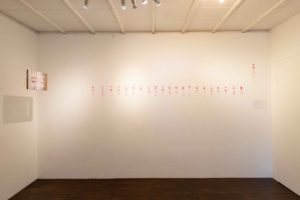
声は文字と異なりかたちがない。林葵衣はこれら見えない声に「かたち」を与えてきた。
その手法は、口紅を塗った唇をキャンバスや壁、窓などに向かって詩や言葉を発話し、声の痕跡=口紅の唇拓を残すというものだ。
画面に現れる声の「かたち」は、林個人の身体性を生々しく可視化するだけでなく、文字や声の形象と抽象性を伝える。
KUNST ARZTで開催された林の個展「詩の復唱」は、「詩」を主題に構成された。林は平仮名を覚えるために仮名を重複させずに網羅した手習い歌「いろは歌」から現代のポップミュージックまで、韻律をもと作られた詩歌を口遊んだ。
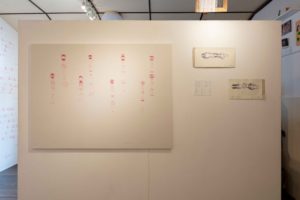
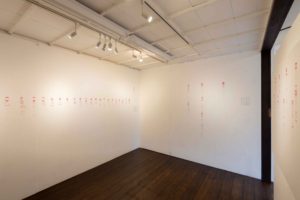
展示は古語のいろは歌から始まる。「いろはにほへとちりぬるを」を発話した《いろは歌》、平安初期の《あめつちの詩》、明治時代に生まれた《とりなくこゑす》が並び、古典に新たな息を吹き込んだ。小品の《Lotus》と《はす》、《格子/grid》では日英で同じ意味の単語を発音し、二ヶ国語の「かたち」の差異を見せる。
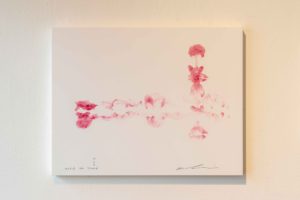
小部屋の壁面には、アメリカのシンガーソングライター、ドン・マクリーンが1971年に発表した自伝的な楽曲《American pie》
が天井から床まで壁全面に発話された。「The day the music died(その日音楽は死んだ)」と何度も復唱されるリフレインは、ダイイングメッセージのように生の痕跡を示す。最後は唇拓した糸の束が解れて空間に消える《声の解体/scrap of voice》で終わる。
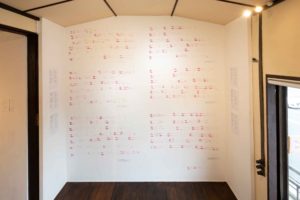
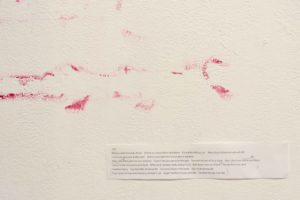
古今東西さまざまな詩歌で選曲構成された本展の出品リスト=プレイリストは、見えるのに読めない意味と発話の違い、二言語、古語と現代語のズレをあらわす声のグラフィスム、口紅のグラフィティだ。
詩の統辞法(シンタックス)が解体した見る詩とも言える本展から想起したのは、1950年代にドイツ、ブラジルで始まった文字や色面で構成する
前衛的な詩の運動コンクリート・ポエトリー(具体詩)だ。日本では漢字による構成詩「闇」「川または州」などを詩作した新国誠一の活動が知られる。
声に出して読むことが不可能な視覚詩の言葉の物質性、音とかたちの探究は本展にも通じる。林は、詩を統辞法や書物から展示空間へ解放し、視覚的、身体的に詩を配置、構成する空間詩へと展開したからだ。
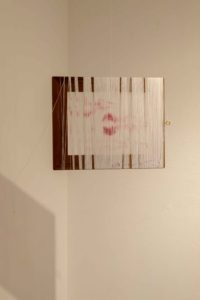
そもそも人類最初の詩は、文字で書かれるのではなく、声で発せられた。その後、人類は文字や印刷、デジタル技術を発明し、声を言葉として記録する活字文化を築いてきた。林の「詩の復唱」は、文字や言葉が画一化してきた現代社会にあって、言葉に生気を取り戻そうとするささやかな運動なのかもしれない。
平田 剛志 (美術批評)
(2019.09.01)
撮影|守屋友樹
Aoi Hayashi Echo of Verse
Lips Graffiti
Voice has no shape unlike letters. Aoi Hayashi has been giving “shape” to invisible voice.
She leaves the trace of voice, meaning leaving lipstick prints, by uttering poems and words on canvases, walls, or windows with her own lips.
The shape appeared on a plane surface of objects visualizes her own physicality vividly and coveys shape and abstractness of letters and voice.
Her solo exhibition, Echo of Verse, at KUNST ARZT is organized on the theme of poetry.
She hummed poetry composed based on meter such as modern pop music,
“Iroha Uta” for children to memorize Japanese Hiragana without repetition of any letters, and so on.
The exhibition started with Iroha Uta in the old Japanese language.
There are poems lined up such as “Iroha Uta”, which has utterance of “i, ro, ha, ni, ho, he, to, chi, ri, nu, ru, o,” “Ametsuchi no Uta” from the beginning of Heian era,
and “Torinakukoesu” created in Meiji Era. She put a new inspiration into the classic literature. Her short pieces, “Lotus” and “Hasu” and “Koushi/Grid,” illustrates the differences of “shape” between the Japanese and English languages by pronouncing the same meaning words. All over the wall, from the ceiling to the floor, in the small room at the exhibition, she uttered the autobiographical song, “American pie,” released in 1971 by the American singer-songwriter, Don McLean. The refrain from the song, “The day the music died,” represents the trace of life as a dying quote. The exhibition finished with “Koe no Kaitai/scrap of voice,”
where a bundle of yarn that has the lipstick prints on was loosened and disappeared in the space.
The list of her artworks of the exhibition, which is considered as the playlist composed of those various poems and songs
from any time and any place, is lipstick graffiti meaning “Graffism” of voice.
It is lipstick graffiti describing the differences of the meaning and pronunciation in the visible but unreadable words.
It is “graffism” representing the differences between the two languages and between the old and modern languages.
The exhibition of poetry to “see,” where syntax of poetry is dismantled, evokes movements of concrete poetry started in Germany and Brazil in 1950s.
Concrete poetry is avant-garde poetry composed of letters and color surfaces. In Japan, it is known that Seichi Nikuni created composition poetry by kanji,
“Yami” and “River or Sandbank” for the movement toward concrete poetry.
The pursuit of materiality, sounds, and shapes of words in unreadable visual poetry leads to the exhibition.
Aoi Hayashi releases poetry from syntax and books to exhibiting space. Moreover, poetry developed into space poetry
which is arranged and composed in visual and physical wise.
Originally, the first poem in human history was not written in letters but uttered in voice. Humanity had created letters, printing, and digital technology,
and built print culture to record voice as words. Aoi Hayashi’s “Echo of Verse” may be a modest movement to bring life back into words in the modern
society standardizing letters and words.
(Takeshi Hirata|Art Critic)
(Kazumasa Ueda|Translator)
